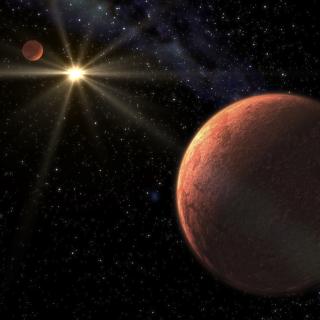Bibcode
von Stauffenberg, A.; Trifonov, T.; Quirrenbach, A.; Reffert, S.; Kaminski, A.; Dreizler, S.; Ribas, I.; Reiners, A.; Kürster, M.; Twicken, J. D.; Rapetti, D.; Caballero, J. A.; Amado, P. J.; Béjar, V. J. S.; Cifuentes, C.; Góngora, S.; Hatzes, A. P.; Henning, Th.; Montes, D.; Morales, J. C.; Schweitzer, A.
Referencia bibliográfica
Astronomy and Astrophysics
Fecha de publicación:
8
2024
Revista
Número de citas
8
Número de citas referidas
7
Descripción
Context. GJ 581 is a nearby M dwarf known to host a packed multiple planet system composed of two super-Earths and a Neptune-mass planet. We present new orbital analyses of the GJ 581 system, utilizing recent radial velocity (RV) data obtained from the CARMENES spectrograph combined with newly reprocessed archival data from the HARPS and HIRES spectrographs.
Aims: Our aim was to analyze the post-discovery spectroscopic data of GJ581, which were obtained with CARMENES. In addition, we used publicly available HIRES and HARPS spectroscopic data to seek evidence of the known and disputed exoplanets in this system. We aimed to investigate the stellar activity of GJ 581 and update the planetary system's orbital parameters using state-of-the-art numerical models and techniques.
Methods: We performed a periodogram analysis of the available precise CARMENES, HIRES, and HARPS RVs and of stellar activity indicators. We conducted detailed orbital analyses by testing various orbital configurations consistent with the RV data. We studied the posterior probability distribution of the parameters fit to the data and we explored the long-term stability and overall orbital dynamics of the GJ 581 system.
Results: We refined the orbital parameters of the GJ 581 system using the most precise and complete set of Doppler data available. Consistent with the existing literature, our analysis confirms that the system is unequivocally composed of only three planets detectable in the present data, dismissing the putative planet GJ 581 d as an artifact of stellar activity. Our N-body fit reveals that the system's inclination is i = 47.0−13.0+14.6 deg, which implies that the planets could be up to 30% more massive than their previously reported minimum masses. Furthermore, we report that the GJ 581 system exhibits long-term stability, as indicated by the posterior probability distribution, characterized by secular dynamical interactions without the involvement of mean motion resonances.
Aims: Our aim was to analyze the post-discovery spectroscopic data of GJ581, which were obtained with CARMENES. In addition, we used publicly available HIRES and HARPS spectroscopic data to seek evidence of the known and disputed exoplanets in this system. We aimed to investigate the stellar activity of GJ 581 and update the planetary system's orbital parameters using state-of-the-art numerical models and techniques.
Methods: We performed a periodogram analysis of the available precise CARMENES, HIRES, and HARPS RVs and of stellar activity indicators. We conducted detailed orbital analyses by testing various orbital configurations consistent with the RV data. We studied the posterior probability distribution of the parameters fit to the data and we explored the long-term stability and overall orbital dynamics of the GJ 581 system.
Results: We refined the orbital parameters of the GJ 581 system using the most precise and complete set of Doppler data available. Consistent with the existing literature, our analysis confirms that the system is unequivocally composed of only three planets detectable in the present data, dismissing the putative planet GJ 581 d as an artifact of stellar activity. Our N-body fit reveals that the system's inclination is i = 47.0−13.0+14.6 deg, which implies that the planets could be up to 30% more massive than their previously reported minimum masses. Furthermore, we report that the GJ 581 system exhibits long-term stability, as indicated by the posterior probability distribution, characterized by secular dynamical interactions without the involvement of mean motion resonances.
Full Tables A.2, A.3, and Tables A.4, A.5 are available at the CDS via anonymous ftp to cdsarc.cds.unistra.fr (ftp://130.79.128.5) or via https://cdsarc.cds.unistra.fr/viz-bin/cat/J/A+A/688/A112
Proyectos relacionados

Estrellas de Baja Masa, Enanas Marrones y Planetas
Se investigan los procesos que conducen a la formación de estrellas de baja masa, enanas marrones y exoplanetas y caracterizar las propiedades físicas de estos astros en varias etapas evolutivas. Las estrellas de muy baja masa y las enanas marrones son probablemente los objetos más numerosos de nuestra Galaxia, pero no por ello están
Rafael
Rebolo López

Exoplanetas y Astrobiología
La búsqueda de vida en el Universo se ha visto impulsada por los recientes descubrimientos de planetas alrededor de otras estrellas (los llamados exoplanetas), convirtiéndose en uno de los campos más activos dentro de la Astrofísica moderna. En los últimos años los descubrimientos cada vez más numerosos de nuevos exoplanetas y los últimos avances
Enric
Pallé Bago